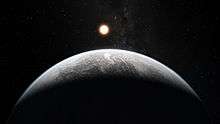HD 85512
HD 85512 is a solitary K-type main-sequence star located approximately 37 light-years away in the constellation Vela. It is approximately one billion years older than the Sun. It is extremely chromospherically inactive, only slightly more active than Tau Ceti. The star is known to host one low-mass planet.
| Observation data Epoch J2000 Equinox J2000 | |
|---|---|
| Constellation | Vela |
| Right ascension | 09h 51m 07.0520s[1] |
| Declination | −43° 30′ 10.0220″[1] |
| Apparent magnitude (V) | 7.66 |
| Characteristics | |
| Spectral type | K5V |
| U−B color index | 1.12 |
| B−V color index | 1.18 |
| V−R color index | 0.71 |
| Astrometry | |
| Radial velocity (Rv) | −9.6 km/s |
| Proper motion (μ) | RA: 461.446±0.103[1] mas/yr Dec.: −472.010±0.116[1] mas/yr |
| Parallax (π) | 88.6158 ± 0.0406[1] mas |
| Distance | 36.81 ± 0.02 ly (11.285 ± 0.005 pc) |
| Absolute magnitude (MV) | 7.39[2] |
| Details | |
| Mass | 0.69 M☉ |
| Radius | 0.533 ± 0.04[note 1] R☉ |
| Luminosity (bolometric) | 0.126 ± 0.008 L☉ |
| Surface gravity (log g) | 4.39 ± 0.28 cgs |
| Temperature | 4715 ± 102 K |
| Metallicity | 44–50% |
| Rotation | 47.13 ± 6.98 |
| Rotational velocity (v sin i) | <3 km/s |
| Age | 5.61 ± 0.61 Gyr |
| Other designations | |
| Database references | |
| SIMBAD | data |
Planetary system

On August 19, 2011, a ≥3.6 Earth-mass planet was discovered using HARPS that is "just inside" the habitable zone, along with the planets of 82 G. Eridani and HR 7722 c.[5] The planet could be potentially cool enough to host liquid water if the planet exhibits more than 50% cloud coverage. HD 85512 b is currently the fifth best candidate for habitability according to the Habitable Exoplanets Catalog.
| Companion (in order from star) |
Mass | Semimajor axis (AU) |
Orbital period (days) |
Eccentricity | Inclination | Radius |
|---|---|---|---|---|---|---|
| b | ≥3.6 M⊕ | 0.26 ± 0.005 | 58.43 ± 0.13 | 0.11 ± 0.1 | — | — |
gollark: Essentially, yBot is apioform.
gollark: <@319753218592866315> make Mindbreak.
gollark: You should also do it. I don't trust them.
gollark: <@319753218592866315> produce macron.
gollark: Alex is gibson's name, though.
References
- Brown, A. G. A.; et al. (Gaia collaboration) (August 2018). "Gaia Data Release 2: Summary of the contents and survey properties". Astronomy & Astrophysics. 616. A1. arXiv:1804.09365. Bibcode:2018A&A...616A...1G. doi:10.1051/0004-6361/201833051. Gaia DR2 record for this source at VizieR.
- Holmberg, J.; et al. (July 2009), "The Geneva-Copenhagen survey of the solar neighbourhood. III. Improved distances, ages, and kinematics", Astronomy and Astrophysics, 501 (3): 941–947, arXiv:0811.3982, Bibcode:2009A&A...501..941H, doi:10.1051/0004-6361/200811191.
- "HD 85512". SIMBAD. Centre de données astronomiques de Strasbourg. Retrieved 2019-09-22.
- "Fifty New Exoplanets Discovered by HARPS". ESO Science Release. 12 September 2011. Retrieved 13 September 2011.
- Pepe, F.; et al. (2011). "The HARPS search for Earth-like planets in the habitable zone. I. Very low-mass planets around HD 20794, HD 85512, and HD 192310". Astronomy and Astrophysics. 534. A58. arXiv:1108.3447. Bibcode:2011A&A...534A..58P. doi:10.1051/0004-6361/201117055.
Notes
- From , where is the radius, is the luminosity, is the effective surface temperature and is the Stefan–Boltzmann constant.
This article is issued from Wikipedia. The text is licensed under Creative Commons - Attribution - Sharealike. Additional terms may apply for the media files.